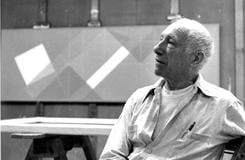
Jack Tworkov: Alexander Gray Associates
Photo: Sarah Wells, 1980
Alexander Gray Associates announces representation of the Estate of Jack Tworkov.
Alexander Gray Associates announces the representation of the Estate of Jack Tworkov (b.1900, Biala, Poland – d.1982, Provincetown, MA). Tworkov emigrated to the United States at the age of thirteen, and attended Columbia College as an English major. Spurred by his sister, the artist Janice Biala, he left the university in 1923 to begin art classes at the Art Students League and the National Academy of Design. During this period, Tworkov also studied under important members of the Provincetown community of artists, such as Charles W. Hawthorne and Ross E. Moffett. In 1958, he established a home and studio in Provincetown, where he continued to spend his summers until his death. The artist’s first works from the 1920s and 1930s reflect the influence of early modernists such as Cézanne, and predominantly feature still-lifes and figurative scenes. Alexander Gray Associates will present a survey exhibition of his work in September 2015.
In 1934, during the Great Depression, Tworkov joined the Easel Division of the Works Progress Administration, where he befriended artists such as Willem de Kooning (the two shared neighboring studios from 1948–1955), Franz Kline, and Mark Rothko. In the Post War years of the late 1940s, he continued his association with these artists, and became a founding member of the seminal Eighth Street Club in 1949, the meeting place for the New York School. He participated in many of the Club’s panel discussions that debated and defined Abstract Expressionism. In 1951, he played a key role in the organization of the important exhibition 9th Street: Exhibition of Paintings and Sculpture at the 9th Street Gallery, New York, which showcased many artists who would become the prominent figures of Post War American art, such as Jackson Pollock, Robert Motherwell, and Lee Krasner. Into the early 1950s, Tworkov maintained a practice of figural abstraction, titling and culling his paintings’ content from Homer’s Ulysses. As the decade progressed, he came to fully embrace abstraction, with works that were based on an underlying structure and rendered with spontaneous flame-like brushstrokes.
A pivotal figure in the development of Abstract Expressionism, Tworkov was also one of the first to question the movement’s commodification, cult of personality, and absorption into academia. In 1965, his painting style shifted radically, as he moved away from overtly gestural Abstract Expressionism to controlled diagrammatic abstraction. Taking an interest in elementary geometry, he turned to the rectangle and its potential measurements as the basis of pictorial composition. He wrote, “All my paintings began with carefully worked out drawings and measurements that I could repeat at will. But the actual painting I left to varieties of spontaneous brushing… I wanted, and hope I arrived at, a painting style in which planning does not exclude intuitive and sometimes random play.” In subsequent work of the 1970s and 1980s, he continued to explore this tension through experimentation with planar illusion, geometric form, the grid, and loose but regulated brushwork. The “Knight Series” (1975–76), in which he created geometric shapes based on the various possibilities of knight pieces’ moves across a chessboard, underscores this conceptual approach.
Throughout his life, Jack Tworkov taught in numerous art departments throughout the United States. Notable appointments include Visiting Artist at Black Mountain College (1952) and Chair of the Art Department of the School of Art and Architecture, Yale University (1963–69). He received Honorary Doctorates from Rhode Island School of Design (1979), Columbia University (1972), and Maryland Institute of Art (1971). In 1976, he was awarded the Distinguished Teaching of Art Award from the College Art Association of America. Tworkov also wrote extensively. His articles were widely published, and his essay “The Wondering Soutine” (1950; first published in Art News) remains an important text in the study of Abstract Expressionism. In 2009, an extensive compilation of Tworkov’s writings were published in The Extreme of the Middle: Writings of Jack Tworkov, edited by Mira Schor.
Jack Tworkov’s work has been the subject of numerous one-person exhibitions, including retrospectives at the UBS Art Gallery, New York (2009); Pennsylvania Academy of the Fine Arts, Philadelphia, PA (1987); Poses Institute of Fine Arts, Brandeis University, Waltham, MA (1965); and Whitney Museum of American Art (1964). His work has been featured in over two dozen Whitney Annuals and Biennials, and two Carnegie Internationals (1952 and 1958). Tworkov’s work is in the collections of prominent institutions including the Museum of Modern Art, New York; Tate Modern, London; Metropolitan Museum of Art, New York; Art Institute of Chicago, IL; Solomon R. Guggenheim Museum, New York; Hirshhorn Museum and Sculpture Garden, Washington, DC; Walker Art Center, Minneapolis, MN; San Francisco Museum of Modern Art, CA; Museum of Fine Arts, Houston, TX; Albright-Knox Art Gallery, Buffalo, NY; Cleveland Museum of Art, OH; Wadsworth Atheneum, Hartford, CT; Harvard University Art Museums, Cambridge, MA; and Indianapolis Museum of Art, IN; among others.